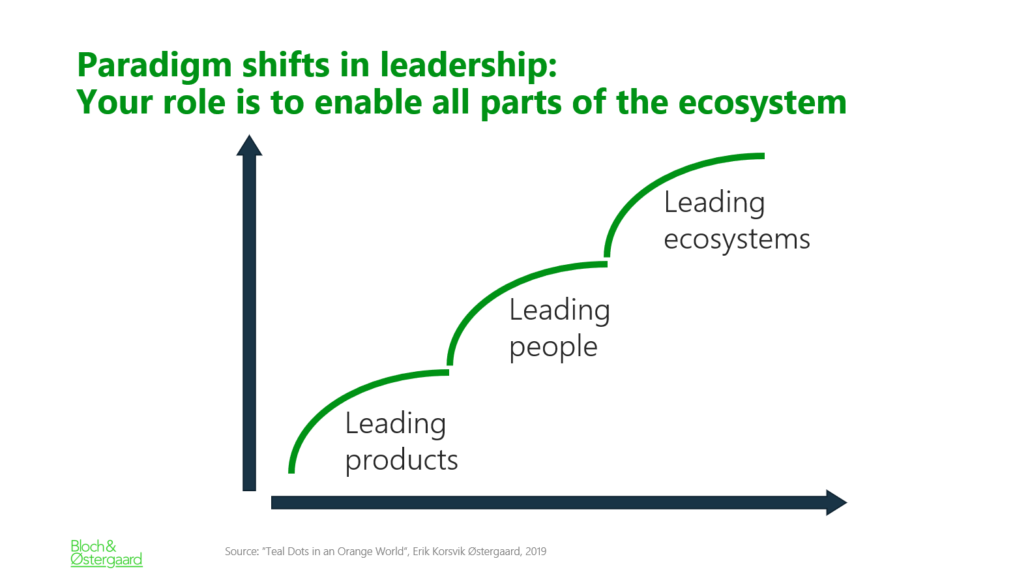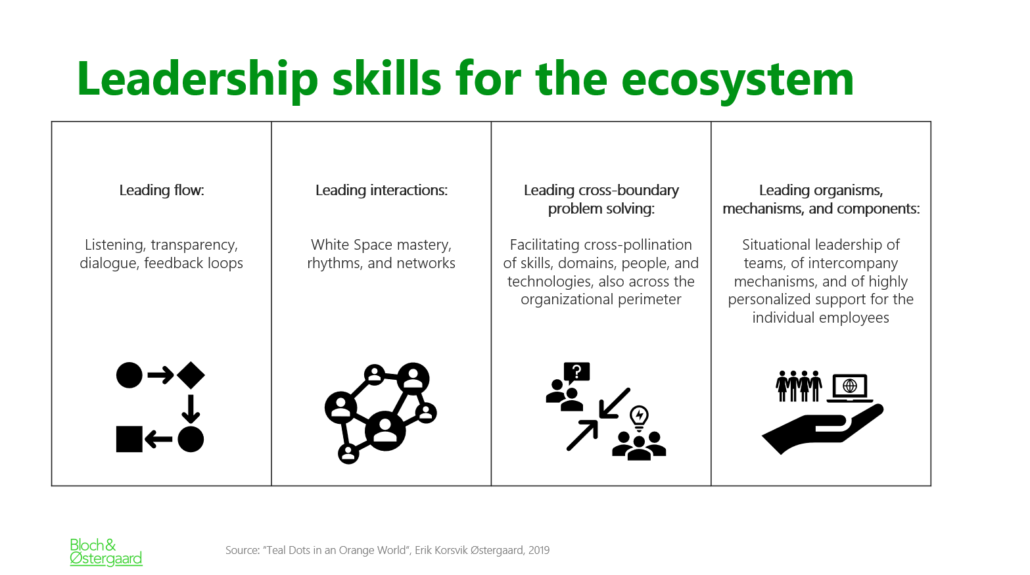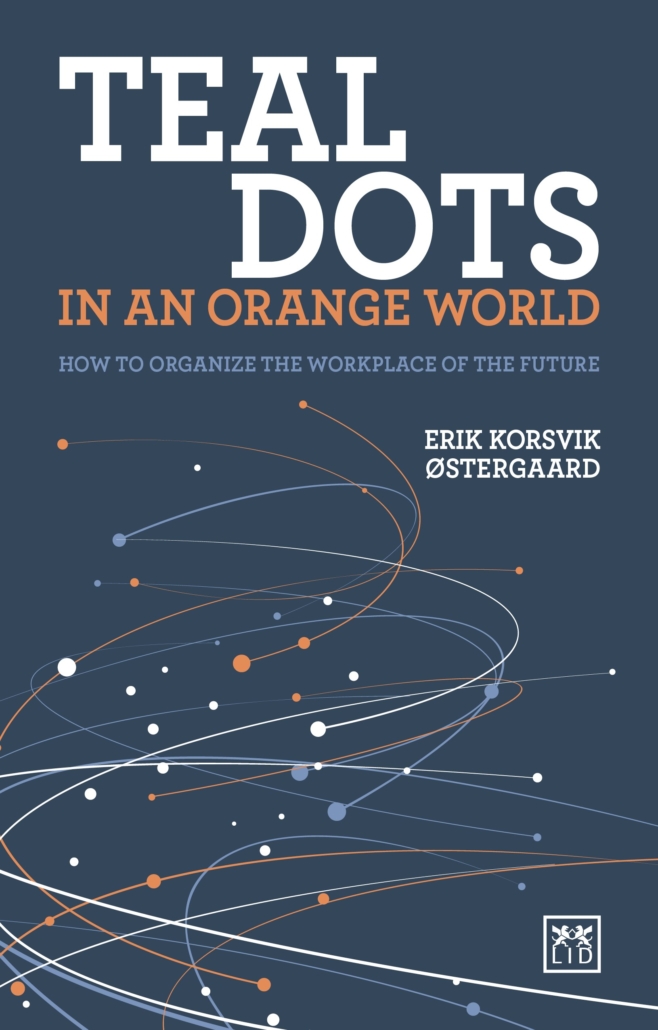How to lead an ecosystem
By Erik Korsvik Østergaard, 25. November 2019
The term “ecosystem” keeps popping up in the sphere of descriptors for New Ways of Working. “The Power of Ecosystems” was even the theme of the Global Peter Drucker Conference 2019 – and I can clearly see why that word and pattern is emerging: In a networked business world, we need to understand the dynamics of our teams and the interactions between them. This has a superb analogy to the nature of ecosystems.
But, how do you lead an ecosystem?
The emergence of a new leadership paradigm
For at least four decades, the approach to management and leadership has undergone massive development, and a paradigm shift in leadership towards ‘leading people’ has been ongoing.
Now, the modern organization is shifting from a hierarchical structure to a sustainable ecosystem. The modern workplace with its self-managed teams-of-teams has precisely such characteristics: a community of living organisms in conjunction with the non-living components of their environment, interacting as a system. With the birth of the idea of more self-managed or autonomous teams, a new approach to leadership has seen the light of day: we are evolving from ‘leading people’ to ‘leading ecosystems’.
Running a command-and-control hierarchical organization is compared to running a machine, like clockwork with well-oiled gears and cogs. Everything is tailored, designed and fitted together, turning in unison.
Running an ecosystem is a fundamentally different task from running a classical, hierarchical organization. An ecosystem consists of many self-managed parts that flow to and from each other, bump into each other, grow or shrink organically, and are affected by the organizational surroundings and mechanisms. They move independently of each other in what looks like Brownian motion but with direction – autonomously but aligned towards a shared direction and a shared purpose. They collide with each other and move buoyantly in the fluid, they float in.
The analogy to the organizational ecosystem is strong. The teams move because of the interactions with other teams and with the modern organization that they exist in. The better you can design and lead that modern organization, the better you can affect the direction of the teams and your people.
Running an ecosystem is about:
- Understanding all the moving parts: both the teams and the people, and the mechanisms that make them move and interact
- Maintaining an overview of the health and maturity of the moving parts and the surroundings
- Nurturing and growing the parts and oiling the interactions
- Infusing energy and nourishment
- Removing the garbage, pollution, and unwanted or poisonous elements
What is your role and tasks?
Leading ecosystems focuses on nurturing culture, organizational dynamics and building relationships, such that the employees themselves can get in the driver’s seat for their engagement with and commitment to the projects and customers.
In addition to leading people, modern leaders lead the ecosystem that the people live in.
Leading ecosystems is the task of:
- Understanding the elements of the dynamic platform that the teams and people live in
- Identifying how to design and develop the elements, and in what priority
- Addressing the interfaces between those elements, between teams and between people
- Constantly fueling and nurturing the dynamic stability of the ecosystem with energy, social capital, positivism, realism, ambition and humanism
- Ensuring that the ecosystem is sustainable
All this must be done while still having a ‘people first’ approach and an orientation towards the future of work.
Here are your four capabilities and skills, that you must master:
Leading flow: Mastering the art of listening, providing transparency to information and decisions, nurturing proper and genuine dialogue, and creating feedback loops for people and reflection.
Leading interactions: Mastering the white space, enabling and insisting on rhythms, and understanding and growing the networks inside and outside the organization.
Leading cross-boundary problem-solving: Facilitating cross-pollination of skills, domains, people and technologies, including across the organizational perimeter, to create better solutions and solve problems.
Leading organisms, mechanisms and components: Being able to identity and nurture the elements in the ecosystem. Applying situational leadership of teams and components, designing and developing intercompany mechanisms, and ensuring relevant and highly personalized support for the individual employees.
The modern leader is Teal at heart
The modern leader is a polymath – that is, their knowledge spans a significant number of subjects, they draw on complex bodies of knowledge to solve specific problems and they are masters of cross-pollinating those skills.
The modern leader is Teal at heart, is responsive and is a leader of an ecosystem. Modern leadership is deeply rooted in sustainability and connectedness.
Your role is to make the ecosystem healthy. Once you succeed, the people and teams will flourish, naturally.
This blogpost is based on an excerpt from Erik Korsvik Østergaard’s second book, “Teal Dots in an Orange World”.
The business world has changed. New kinds of organizations are emerging, and everybody is talking about sociocracy/holacracy, agile, lean startup, and teal. The challenge is, that these structures are extremely hard to scale to corporate businesses, with thousands of employees.
This book addresses exactly this: How do you create an organizational platform and ecosystem, so that modern progressive “dots” can emerge? And with that, what leadership is required for this ecosystem?
Want to know more?
Send me an email
and I’ll get back to you!
Looking for a thought-provoking speaker
with knowledge of the future
and how to turn it into daily life?
Do you need input on how to get started?
Take a look at at our categorized toolbox here
– it’s all free









